Orange bugs come in different sizes. Tiny bugs are sometimes orange. They can become orange as adults or have orange coloring as nymphs.
Some of the most common tiny orange bugs are those humans come in contact with.
Chiggers are an example of bugs that people come in contact with, mainly in the summer.
Concrete mites are another species of small orange bugs people may encounter. These bugs are seen around driveways and sidewalks.
The following species of tiny bugs have different orange nuances.
1. Chiggers – Tiny Orange Bugs That Bite
Chiggers are mostly orange but they can also be red or yellow.
These tiny colorful bugs are known to be problematic for humans as they attach themselves to clothes or directly to the skin and bite.
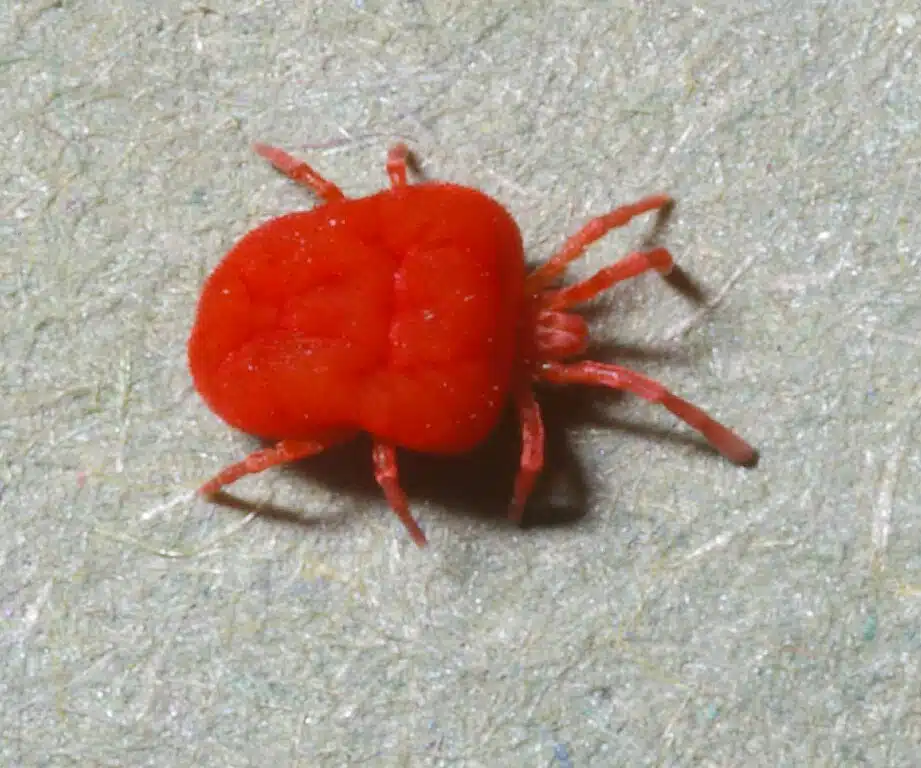
Chigger bites are painful, and itchy, and may lead to rashes that last days.
The bugs are mostly feared by humans but they may fall off the skin within 2-3 days on their own.
Chiggers don’t bore into human skin which means you can get them off with the right techniques.
It’s important to remove chiggers as these bugs have injected enzymes that cause itchiness and even allergic reactions.
Multiple homemade remedies are used on chiggers to make them fall off the skin before they cause infections.
Acetone or nail polish may be used to make chiggers fall off. Some types of strong alcohol have a similar effect, making chiggers fall off.
These orange bugs aren’t necessarily interested in humans for food as they feed on plants.
Chiggers also eat arthropods, particularly those of a smaller size.
Humans are known to come in contact with chiggers when they bite.
Chigger bites tend to lead to itchiness, which goes away in a few days or an extended interval of up to 2 weeks on its own.
Severe itchiness needs to be addressed. You need to wash the itchy areas with soap and water.
Anti-itching lotions can then be applied to the skin.
2. Thrips
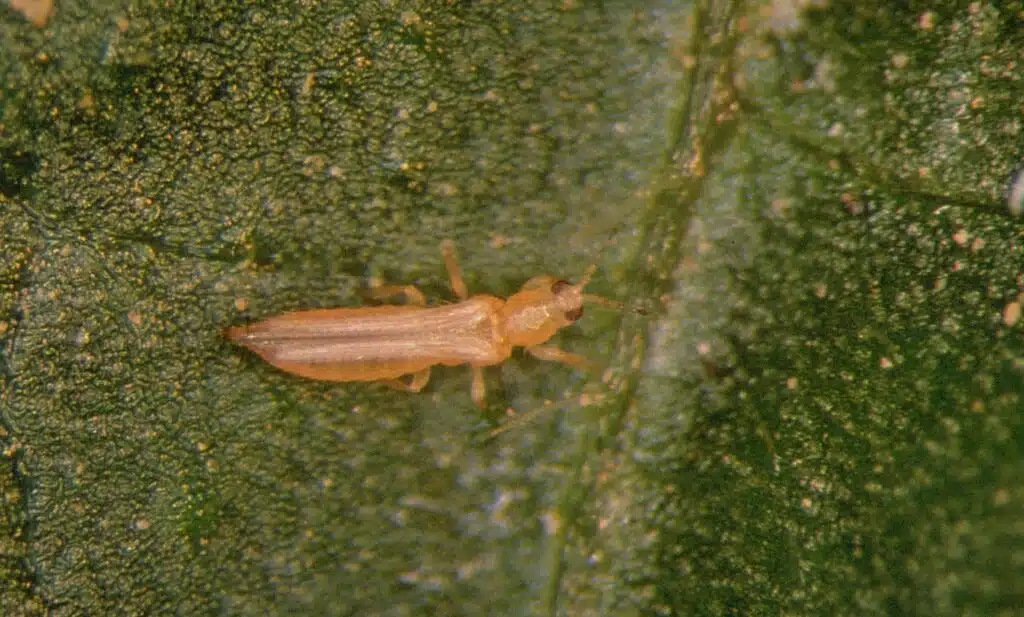
Thrips come in different colors. Citrus thrips have a pale orange color.
These are some of the oldest insects with a pollination role in the world. By some studies, thrips are the oldest pollinating insect surviving today.
However, not all roles this insect plays are positive as they can also be detrimental to plants.
One of the ways thrips are detrimental is by forming galls, mainly on the host of citrus trees and other host plants they feed on.
Most importantly, thrips play a negative role in agriculture as common tiny pests are very difficult to control.
Feeding on legumes, these types of orange bugs essentially lower the production rates of various crops.
Furthermore, thrips carry plant diseases which means they can compromise entire crops.
Another common problem associated with thrips is their increasing resistance to the insecticide. This means these insects eventually stop reacting to heavy insecticide use.
New ways of eliminating thrips are often sought by farmers.
The introduction of parasitic wasps species is among the few control methods thrips are tied to.
These bugs can travel short or long distances easily. Some thrips are wingless but they may still travel long distances.
Climbing to the tips of plants, thrips leap in the air to catch air currents that transport them.
These air currents are normally carrying thrips during the summer. As a result, the bugs can end up in urban areas, on crops, or anywhere the wind blows.
3. Bed Bugs – Tiny Orange Bugs in Bed
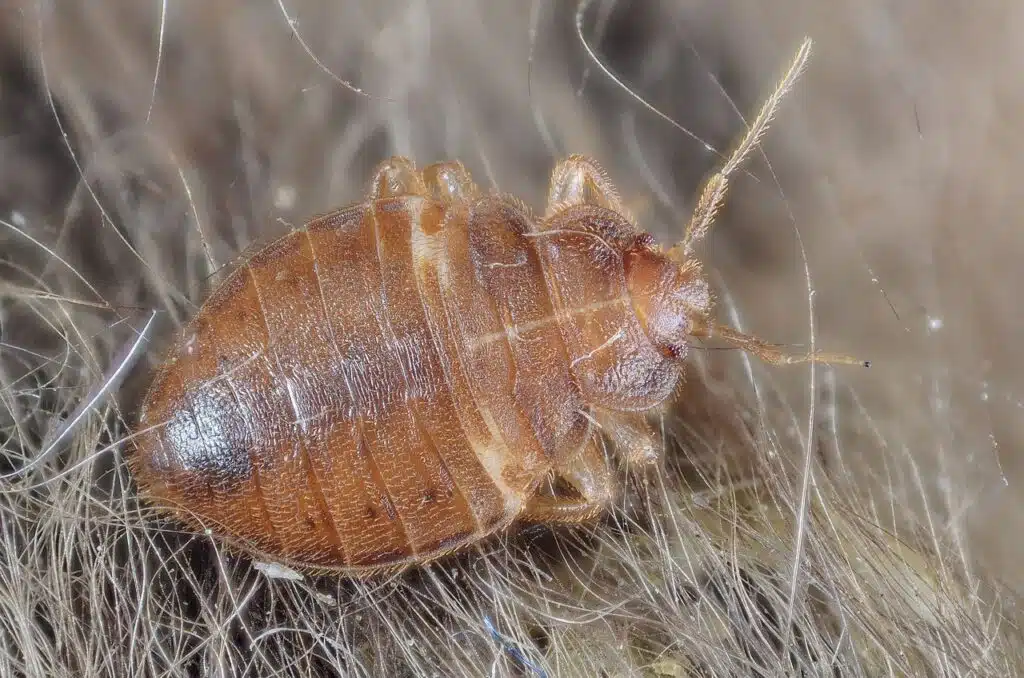
Immature bed bugs have an orange color. They reach a final orange-brown or orange-red color as adults.
Not as large as ¼ inch adults, immature bed bugs are almost twice as small as the adults of the species.
They soon become adults posing all of the risks to humans that bed bugs are known for.
The easiest way to have your home infested with bed bugs is by introducing them from another infested environment.
You can carry them to your bedroom on clothes, either from the outdoors or from other infested homes.
Some people introduce bed bugs to their homes after traveling or after visiting poor sanitation hotels.
These bugs feed on blood and they eventually die without a human host.
Getting rid of them involves deep cleaning and even discarding bedsheets, clothes, and other textiles that came in contact with the bugs.
Finding bed bugs on your bed might not be a straightforward process as these tiny bugs prefer to hide in dark places on the bed or the mattress.
They live traces behind which gives their presence away.
Feces with blood are the main sign of bed bug infestations on a bed.
Large bed bug infestations are rarely dealt with properly without the help of a professional. While most settle in beds, close to humans, bed bugs might also survive on carpets and elsewhere around the house.
4. Clover Mites – Tiny Orange Bugs On Window Sill
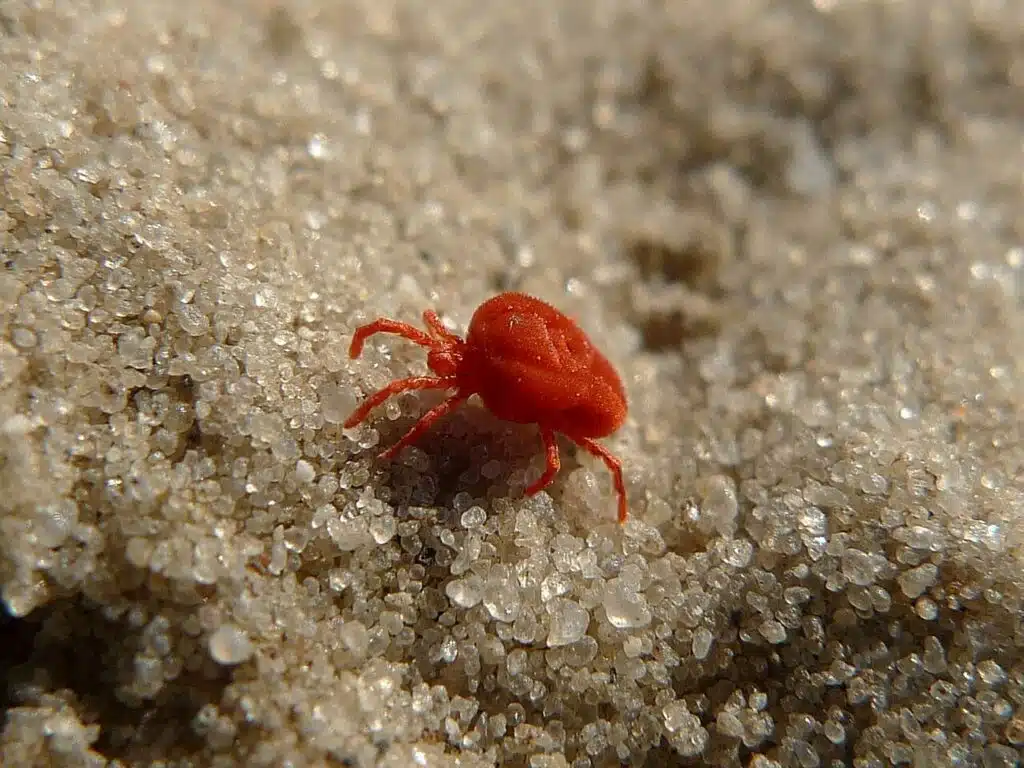
Clover mites come in orange-red or in red color as fed adults.
Starting life as red spherical eggs, these mites can make their way indoors.
Overwintering as eggs, they appear in the spring and summer seasons, particularly on lawns.
Fertilized and especially overly-fertilized lawns attract clover mites. These tiny bugs eventually damage the lawn in the area they live.
A sign of their presence on your lawn includes dry grass patches. These can be small or large patches, depending on the infestation levels.
Clover mites can also get indoors if the lawn is close to the house.
These bugs don’t have a pest status for homes as they don’t create any physical damage nor do they spread any viruses.
High multiplication rates are among the most common reasons clover mites are so present both around and inside homes.
These bugs don’t multiply by mating as their first generation is only represented by females that already lay fertilized eggs.
Hundreds of eggs are laid at a time which means there are high chances of at least some clover mites making it indoors from the lawn.
5. Ladybugs
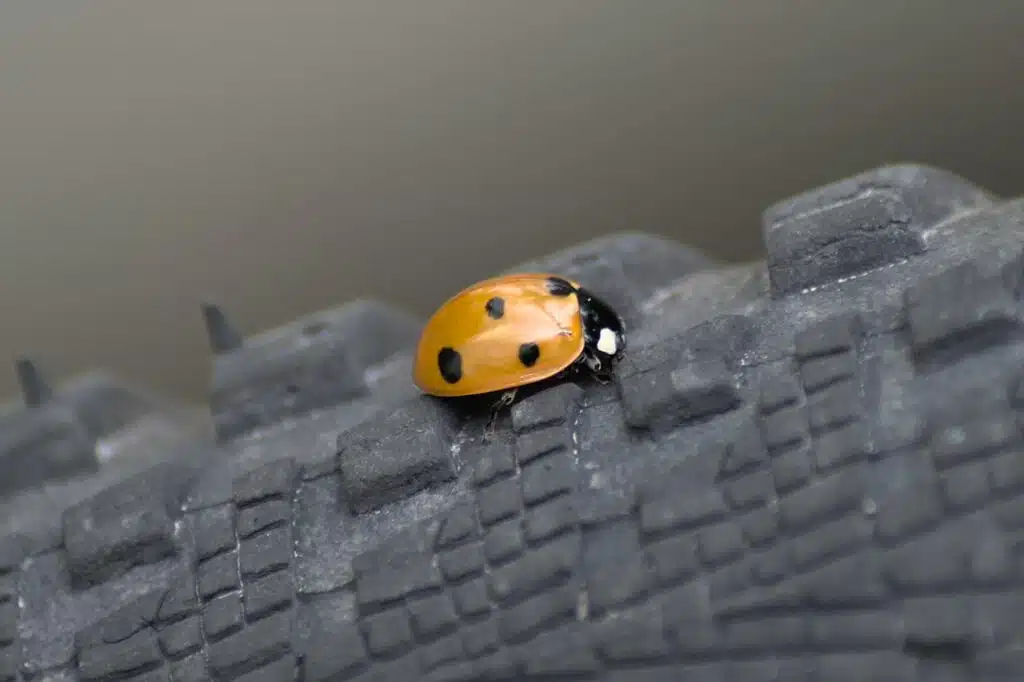
Not all ladybugs are red, some are orange.
Asian Lady Beetles have a base orange color, albeit it can also be tan or even red.
The orange morph of the species comes with black spots across the elytra and a typical ladybug’s round dome-shaped body.
Small but good predators, these ladybugs are newly introduced to North America.
They only have a presence going back a couple of decades as they were introduced from Asia, as their name suggests.
Asian Lady Beetles are known for being attracted to light. They can move indoors by flying, particularly at night, when you turn the lights on.
Indoor survival is not possible within the species. Ladybugs of this genus cannot survive nor multiply inside the house.
Instead, they will seek ways to move out of the house whenever they don’t find any food.
Asian Lady Beetles are also known for not surviving long times indoors without any insects to feed on.
These lady beetles leave yellow traces with a foul smell behind them when handled. They might live these yellow stains on white walls or white doors inside of the house.
No particular measures need to be taken against Asian Lady Beetles.
Sealing all entry points such as cracks in walls is recommended to keep these bugs out.
Insecticides aren’t needed to keep these bugs out as they have a beneficial role in the garden where they eat invasive bugs and because they rarely move indoors.
Overwintering is specific to the species.
The process where these bugs prepare for winter starts in the fall, as temperatures start to drop.
Bugs of this genus start to look for sheltered retreats where they hide from low wintertime temperatures.
Homes, barns, and garages are among their favorite hiding spots.
Sunny fall days are believed to offer the ideal conditions for these bugs to start looking for indoor places to hide in.
October is the typical month when these bugs look for indoor hideaways in the Northern and Central habitats of North America.
6. Wasps – Orange Bugs That Fly
Wasps may come in yellow and black colors but they’re also found in orange colors. Ichneumonidae genus is known to have a few species of orange wasps.
- Trogus Pennator
Orange is the main color of this wasp in the Ichneumonidae genus. Growing up to a size of 0.7 inches, this species has an almost worldwide distribution.
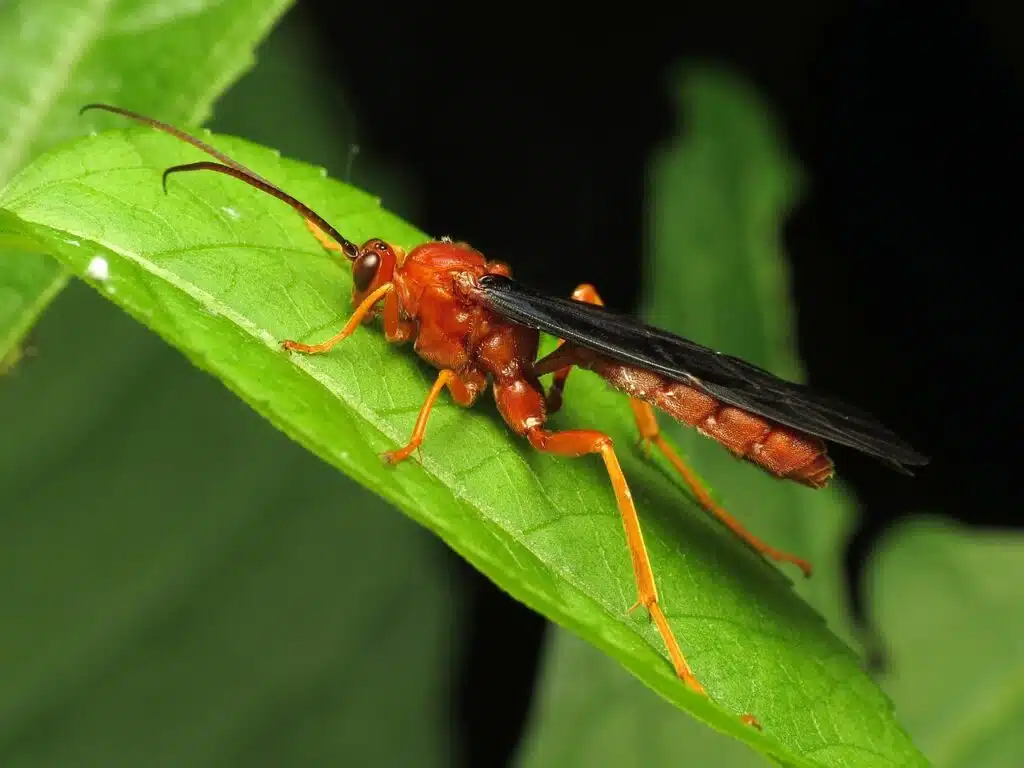
Its orange body and black wings make the species stand out. The wasp is one of the most common parasites of swallowtail larvae and pupae.
Wasps of this genus lay eggs directly in caterpillars. Some of them may lay eggs in multiple swallowtail butterfly caterpillars.
- Sphex Lucae
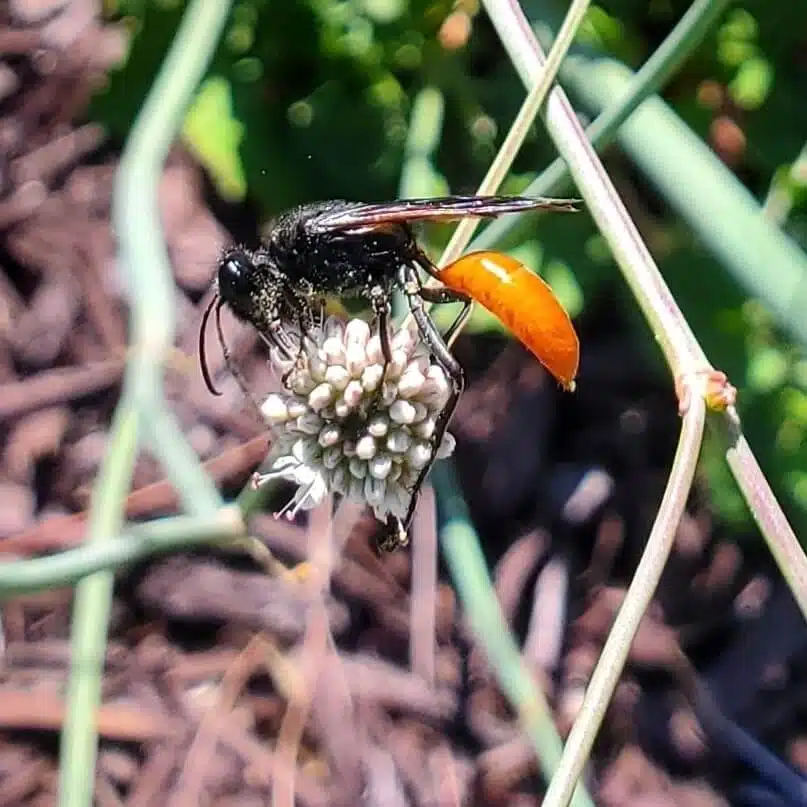
Females of this species are mostly orange with a black upper body.
The females of the species are avid predators of katydids. They hunt katydids and amputate their legs.
After the prey is immobilized, the female Sphex Lucae wasps drag the insects into a dug nest where an egg is laid on it to serve as food for its emerging larvae.
- Enicospilus purgatus
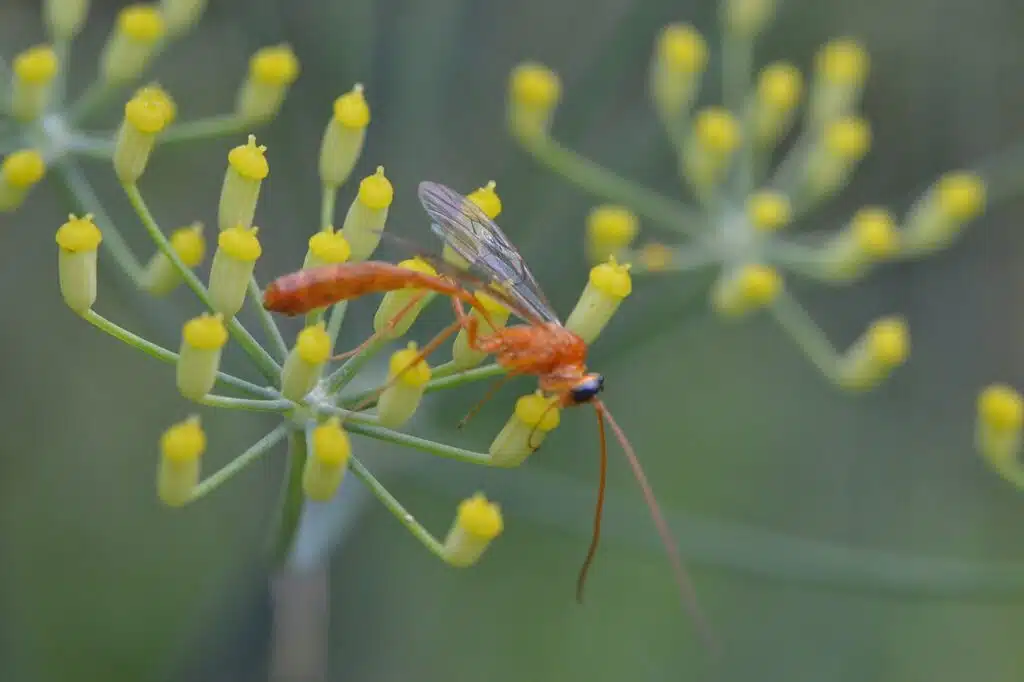
These wasps have a pale orange color. This color has an almost translucent nature to it.
Its faded color as well as its transparent wings make this species resemble crane flies.
Enicospilus purgatus are wasps that can make it indoors attracted to light as nocturnal fliers.
7. Springtails – Tiny Orange Jumping Bugs
Springtails come in different colors including orange, blue, black, and yellow. The following species are known for being completely orange.
- Vitronura giselae
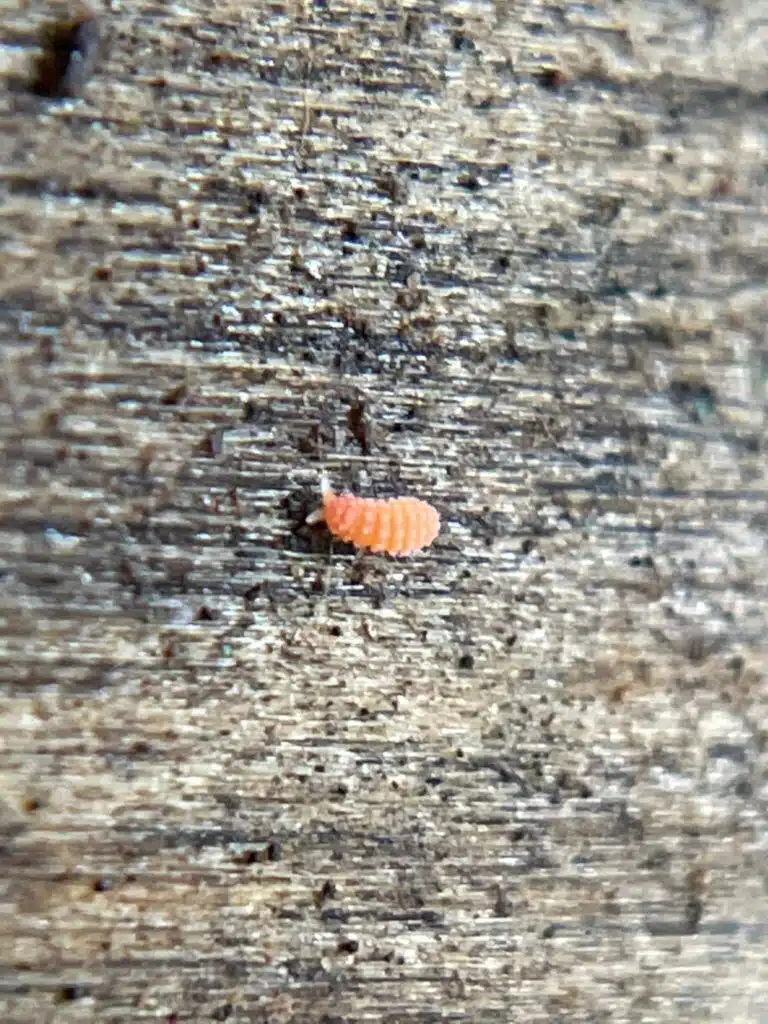
These types of tiny springtails have a bright orange color.
The role of the species is to break down organic matter. The eating habits of the springtails give them a beneficial role.
These springtails eat dead leaves, feces, and other organic matter.
- Bilobella braunerae
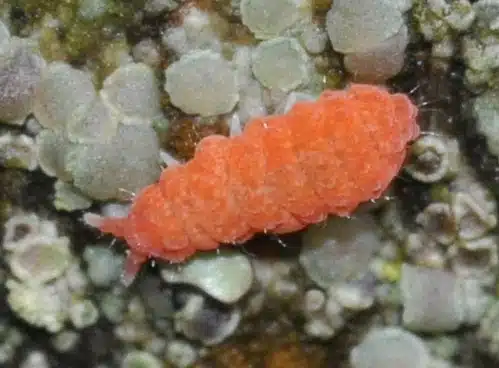
Dark orange is the main color of these springtails. Native to Europe, the species has a ridged body with small orange protrusions.
It lives in dead trees. Most of these springtails are found under tree bark.
8. Aphids – Tiny Orange Bugs on Plants
Aphids are found in various orange nuances across multiple species. Some of the most common orange aphids are Olander aphids.
Also known as milkweed aphids or sweet pepper aphids, Olander aphids (Aphis nerii) come in orange or yellow color with contrasting black legs.
They can be seen on host plants such as milkweed, dogbane, or morning glory.
Only plants that are heavily fertilized or not very healthy are attacked by these aphids, typically in very high numbers.
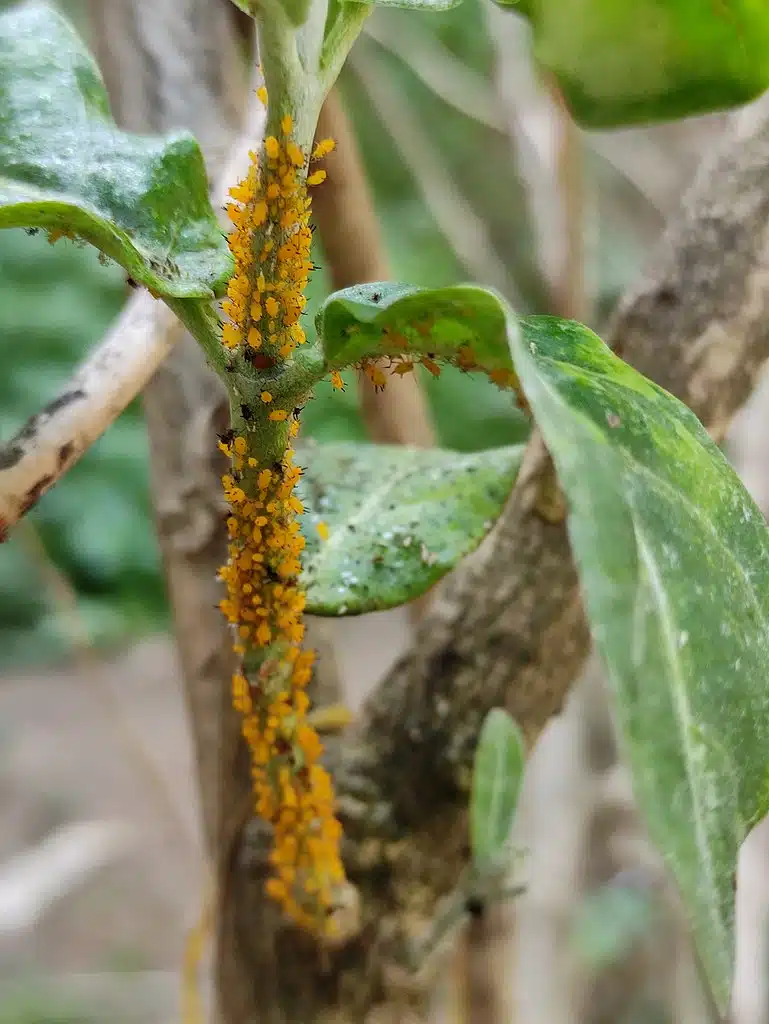
Oleander aphids are some of the most detrimental tiny orange bugs since they can spread to a large number of plants, including peppers.
There are a few reasons why Oleander aphids are the most common tiny orange bugs in gardens.
- High nitrogen concentrations (heavy fertilization)
Using fertilizer is beneficial for gardens. However, using too many fertilizers eventually stresses plants.
Oleander aphids tend to thrive on plants that live in soils with very high levels of nitrogen.
These are soils you’ve applied too much fertilizer on.
- Too much or too little water
Plant stress is often a cause of weak health. This is why using too much water or watering plants insufficiently are also causes of Oleander aphid invasions.
You can see these invasions as these bugs tend to cover hosts’ plant leaves, stems, and flowers completely.
- A low number of predator species
Oleander aphids can multiply rapidly.
Gardens that don’t have sufficient natural aphid predators tend to be overwhelmed by these tiny bugs.
Some of the most common milkweed aphid predators include predatory mites, ladybird beetles, and predatory beetles.
9. Potato Beetles
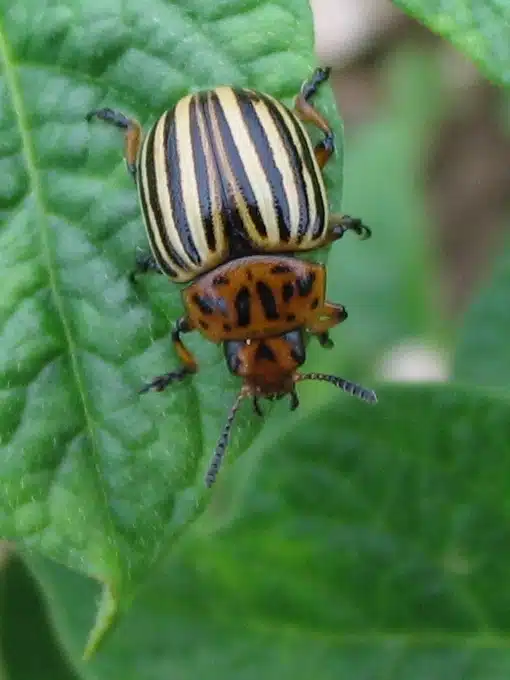
Colorado potato beetles are among the most common bugs on potatoes.
These beetles come with orange and black or yellow and black coloring. These are some of the most common species feeding on potato plants.
Growing to a size between 0.2 and 0.4 inches, this potato beetle can come with alternating orange and black stripes across the elytra.
The orange coloring is dominant at a point in the life of the Colorado potato beetle. This species is mostly orange, with just a few black dots, in its 4th larval instar.
The beetle measures around 8mm at this stage.
While it only spends up to 10 days in a larval stage, the Colorado potato beetle can quickly overwhelm a potato crop or garden.
It mostly feeds on potato plants but it can also expand its hosts to other legumes.
You can identify these bugs as eggs on plants and remove them before they turn into larvae.
Colorado potato beetle eggs are yellow and found in batches.
Tens of yellow eggs can be found under potato leaves.
Bugs of this genus are native to North America.
They have been introduced to Europe where they continue their detrimental role on crops.
Apart from insecticide, these bugs can be controlled by promoting more natural predators around potatoes.
Some of the common predators of these orange and black bugs include spiders and beetles. Predatory ground beetles are among the most efficient against Colorado potato beetles.
10. Grapevine Beetle
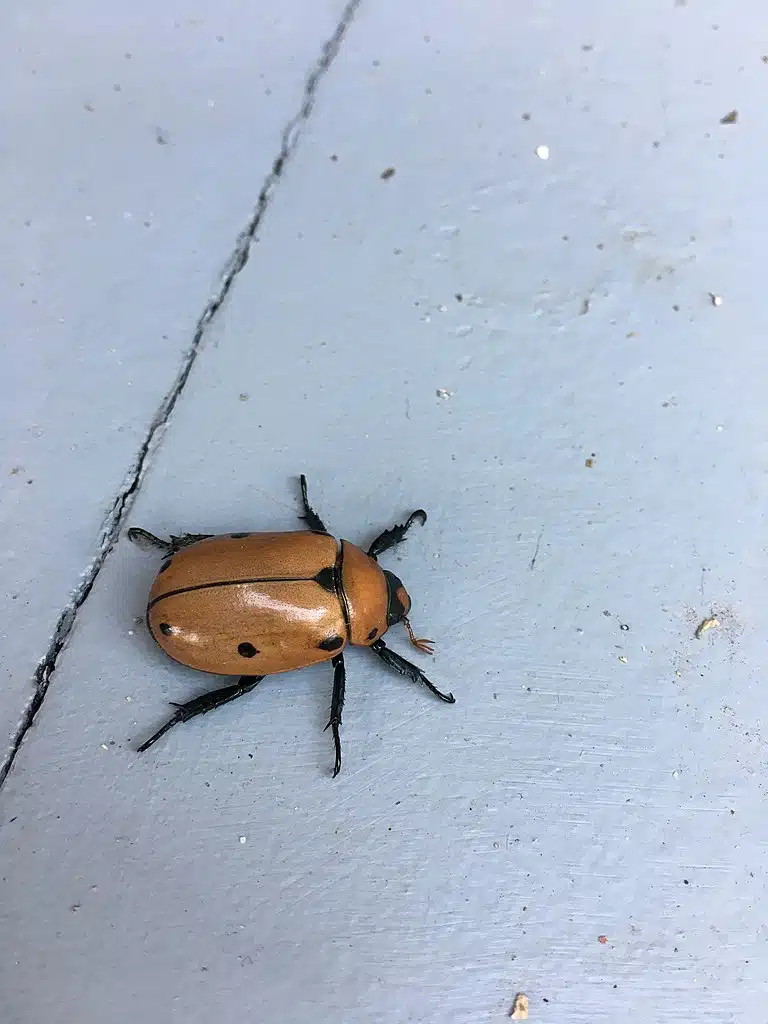
Grapevine beetles(Pelidnota Punctata) have a yellow-orange color. These bugs are relatively small with a size that varies from 1 to 2 inches.
You can find these colorful bugs on wild and cultivated vines and grapevines.
It feeds on leaves and fruit, which means it has a detrimental role in the garden.
Common around vineyards, this is a species that needs to be managed so that it doesn’t lead to economic losses.
Also found in woodlands, this species has adapted to laying eggs in a different place, not on vines themselves.
It may lay eggs in any type of rotten wood it finds in woodlands.
This species often lays eggs in decaying trees.
At the same time, it has adapted to laying eggs next to vines themselves, whenever it doesn’t live in or next to woodlands.
11. Spiders
Spiders come in all sizes and colors. Different species of orange spiders are found across North America and around the world.
- Marbled Orbweaver
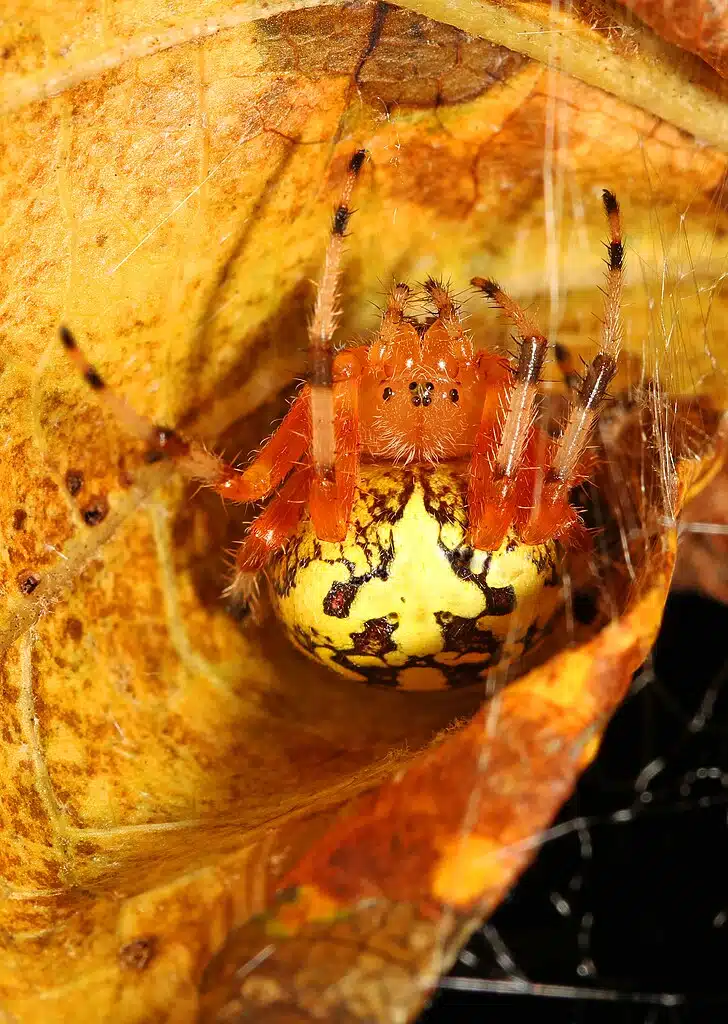
Orange nuances are specific to Marbled Orbweavers.
A yellow morph and an orange morph are characteristic of this species.
The orange Marble Orbweaver is almost completely orange in the case of females. Also known as the Pumpkin spider, this is a type of female with a bulbous orange body.
Male orange-morph Marble Orbweaver spiders have orange legs and an orange head.
- Woodlouse Spider
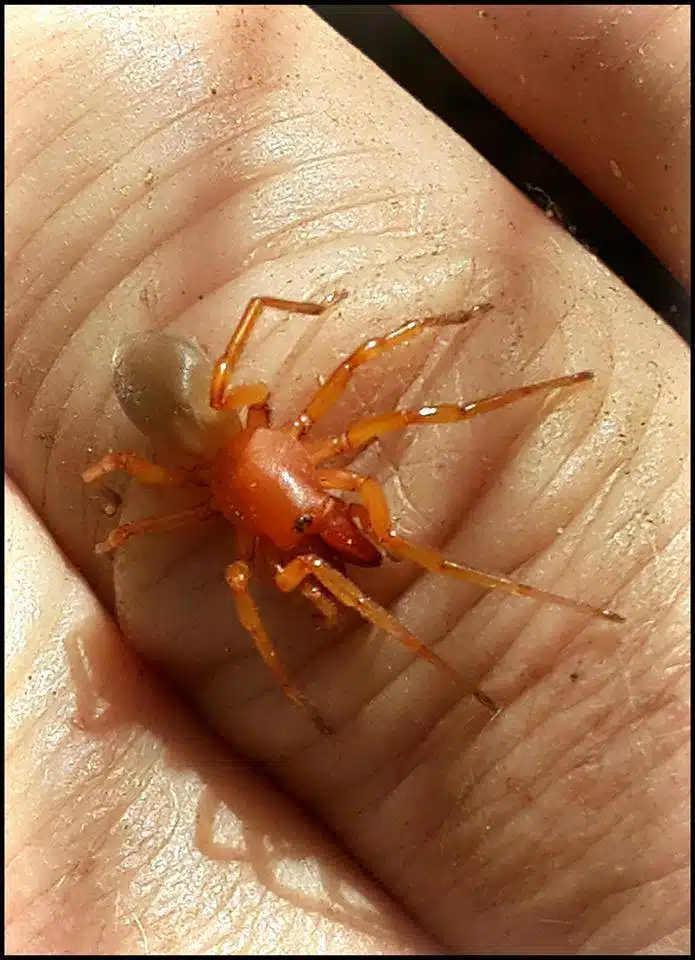
Native to North America, Europe, Asia, Africa, and Australia, the Woodlouse spider is one of the most common orange species in the world.
It’s not an entirely orange spider. Only its legs and cephalothorax are orange. Its abdomen is gray or yellow-brown.
Also known as the Sowbug Killer, this spider has a reduced size. It grows to a maximum size of 30mm.
- Cardinal Jumping Spider
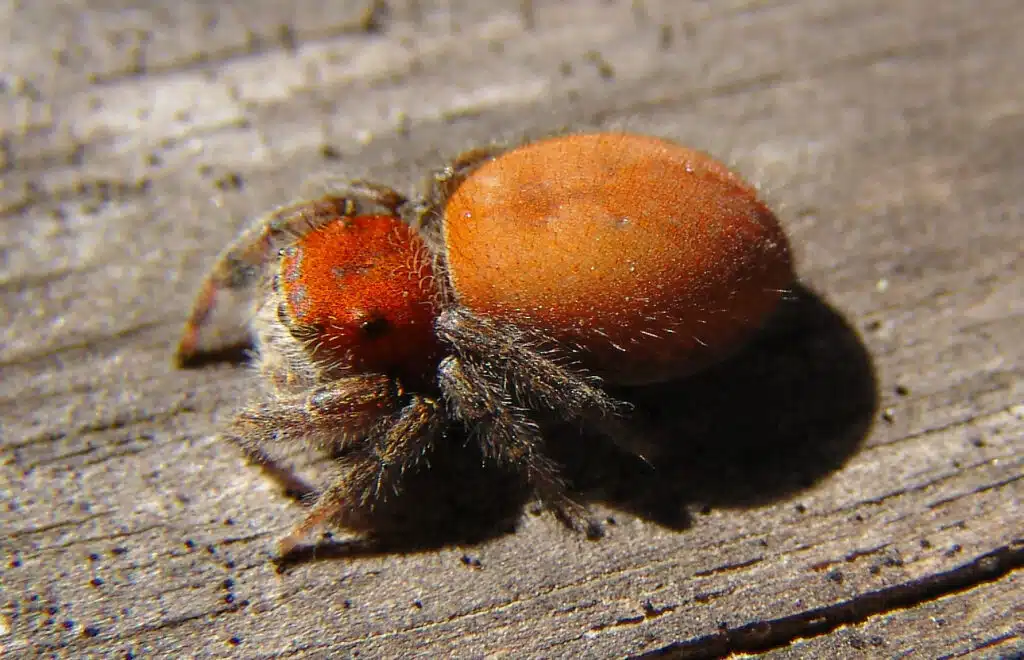
A mostly orange body is specific to the Cardinal Jumping spider. Black is a secondary color in the species.
These spiders are known for mimicking wasps.
Spiders of this family shouldn’t be handled as they can sting.
12. Milkweed Bugs – Tiny Orange Bugs on Milkweed
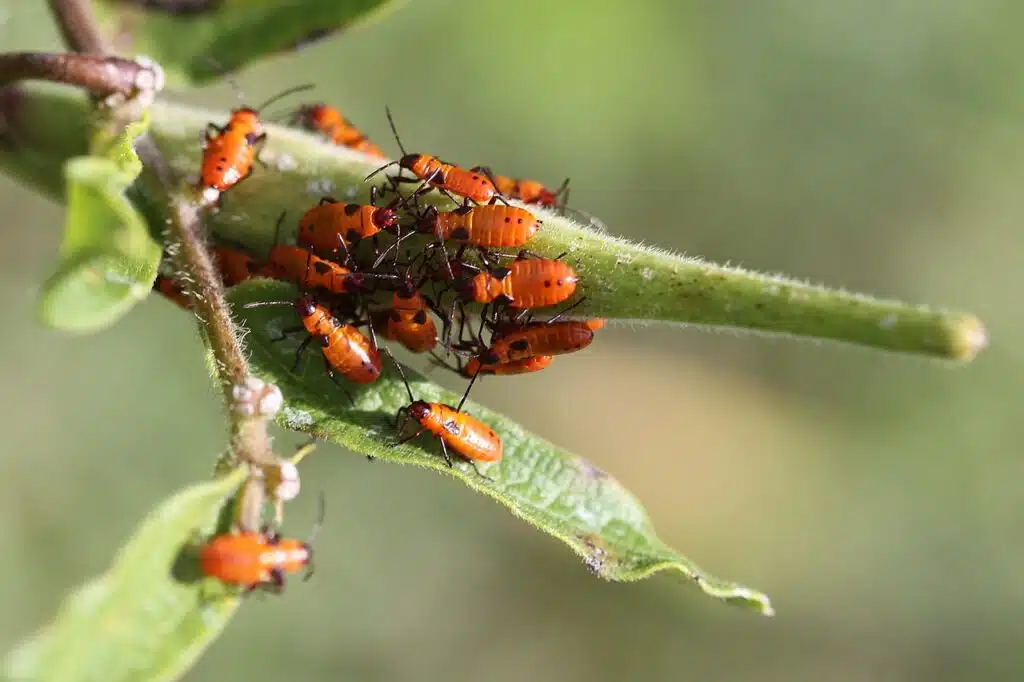
Milkweed bugs have orange coloring through different life stages.
As adults, Milkweed bugs show a combination of orange and black colors across the body.
As nymphs, these bugs can be entirely orange with black legs, similar to young Oleander aphids.
These bugs invade milkweeds in high numbers.
They feed on seed pods but they aren’t as detrimental as aphids.
13. Water Mites – Tiny Orange Bugs in Pool
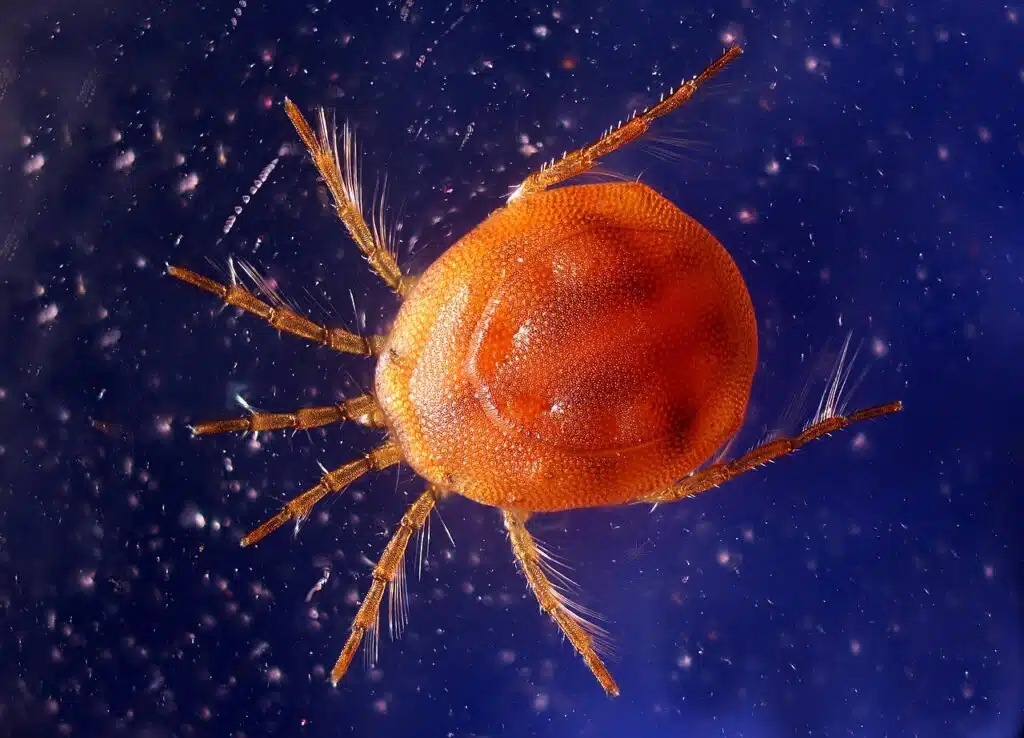
Water mites come in orange, red, or orange-red colors.
These colorful nuances of these mites make these species stand out. They live in waters around the world, including streams, lakes, rivers, and ponds.
Water mites are among the species found in thousands of sub-species. Most of these sub-species are parasites.
They attach themselves to mosquitoes and other species that live or breed in the water.
In North America, water mites use different types of water-dwelling insects as hosts for their eggs.
A reduced size allows water mites to lay eggs on different insects and flies.
Apart from mosquitoes, water mites also lay eggs on gnats and dragonflies. Tiny orange eggs can be seen on the wings of these water-dwellers.
14. Concrete Mites – Tiny Orange Bugs on Concrete
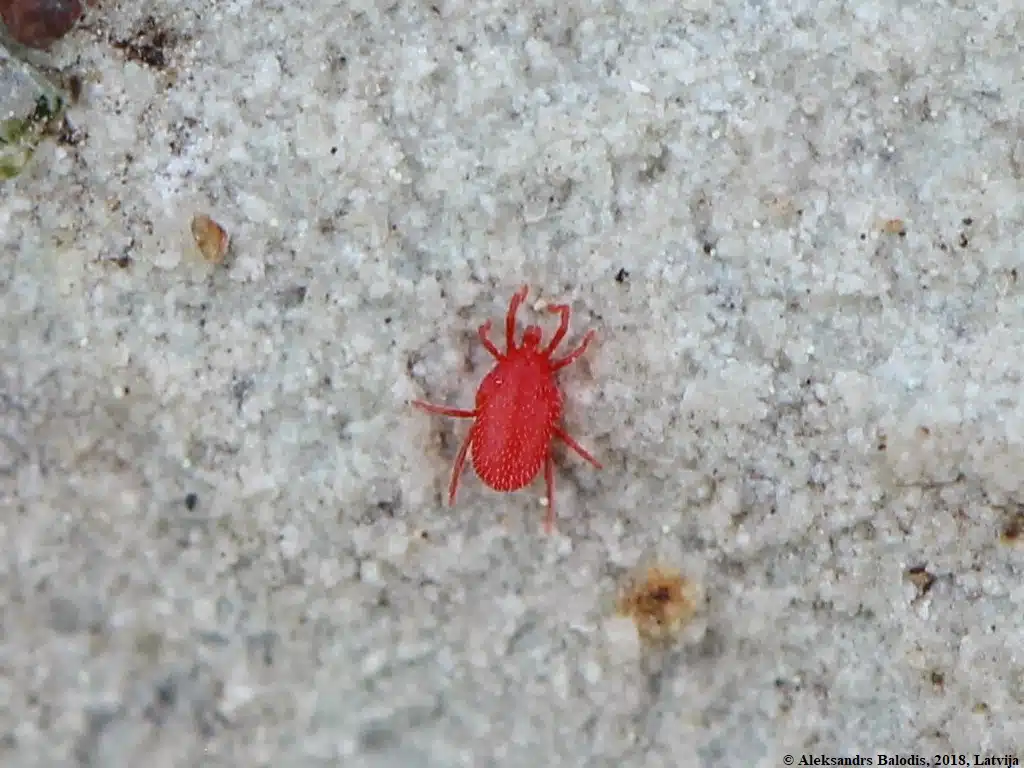
These types of tiny bugs are known to gather next to or under concrete. This is a safe humid and dark habitat for the species.
Orange with a red hint is the only color of the species. These bugs have an orange body, orange legs, and an orange head.
The size and the color of the species often make people confuse concrete mites with clover mites.
Concrete mites only grow to a full size between 1 and 2mm.
These bugs aren’t pests and they don’t invade homes.
No particular measures are needed against concrete mites around the house.
They tend to die as quickly as they spread, typically within days.
15. Orange Assassin Bug
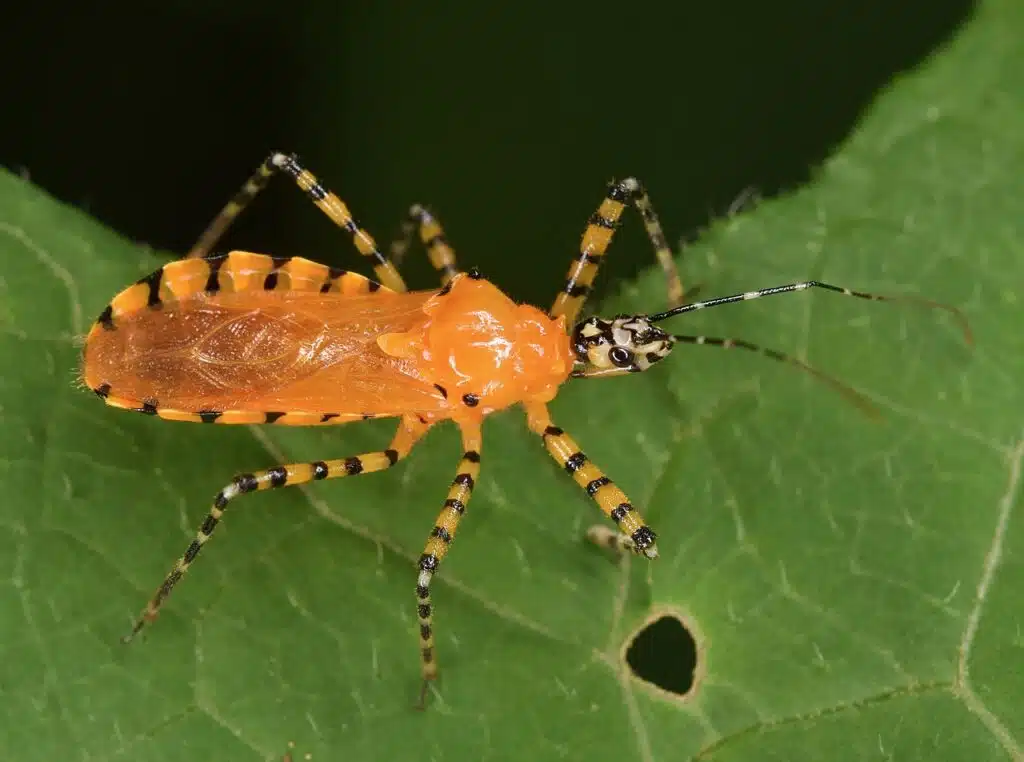
These types of bugs (Pselliopus Barberi) grow to about 0.5 inches.
Orange is the main color of the species, followed by yellow and black.
These types of bugs are found on various flowers where they await small insects to feed on.
You can identify these bugs on flowers by their vivid orange body and their yellow legs that show black bands.
The species has a wider lower abdomen.
Orange Assassin Bugs shouldn’t be handled. They can sting.
These bugs might only pose a problem in the spring and the first few weeks of the summer. This is the period when they multiply rapidly.
Adults overwinter under logs and rocks from fall to spring.
16. Leaf-footed Bug Nymphs
Multiple species of Leaf-footed Bug Nymphs are orange.
The nymph of Eastern Leaf-footed Bug Nymphs (Leptoglossus phyllopus) has an orange body with black legs.
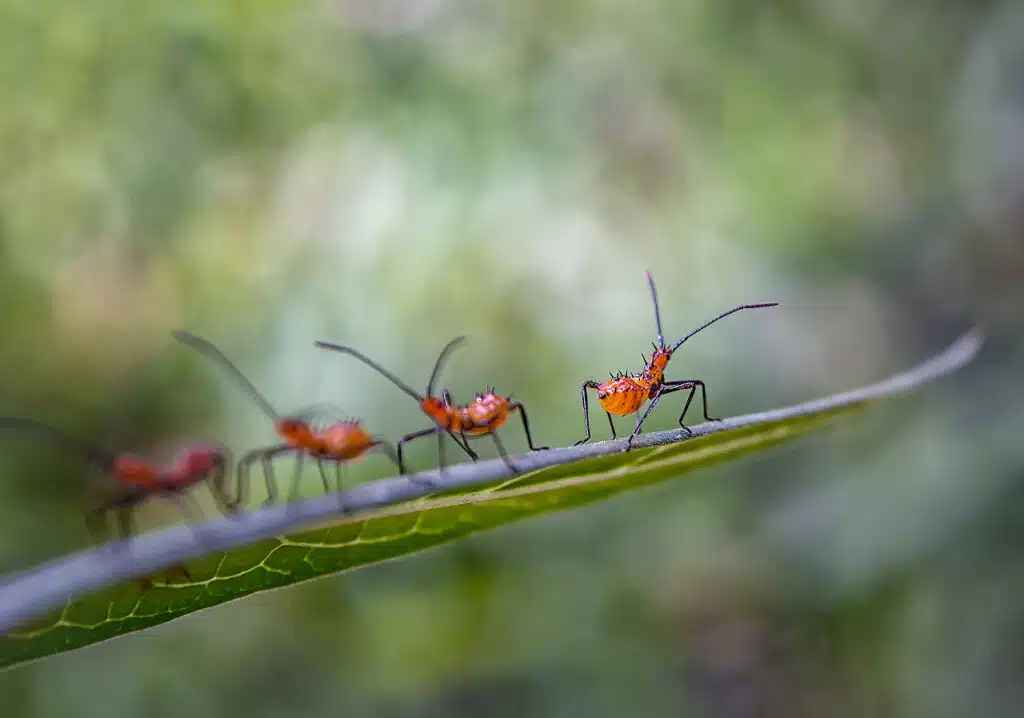
This nymph has a reduced size, typically under 0.5 inches.
Florida is one of the US states where this species has infiltrated. Thistle used to be one of the few plants the nymphs were reported on.
This has changed over the past few years as the Eastern Leaf-footed Bug Nymph is now seen on citruses.
Tangerines are among the citruses affected by these nymphs. Spraying insecticide is one of the methods used to keep the species away.